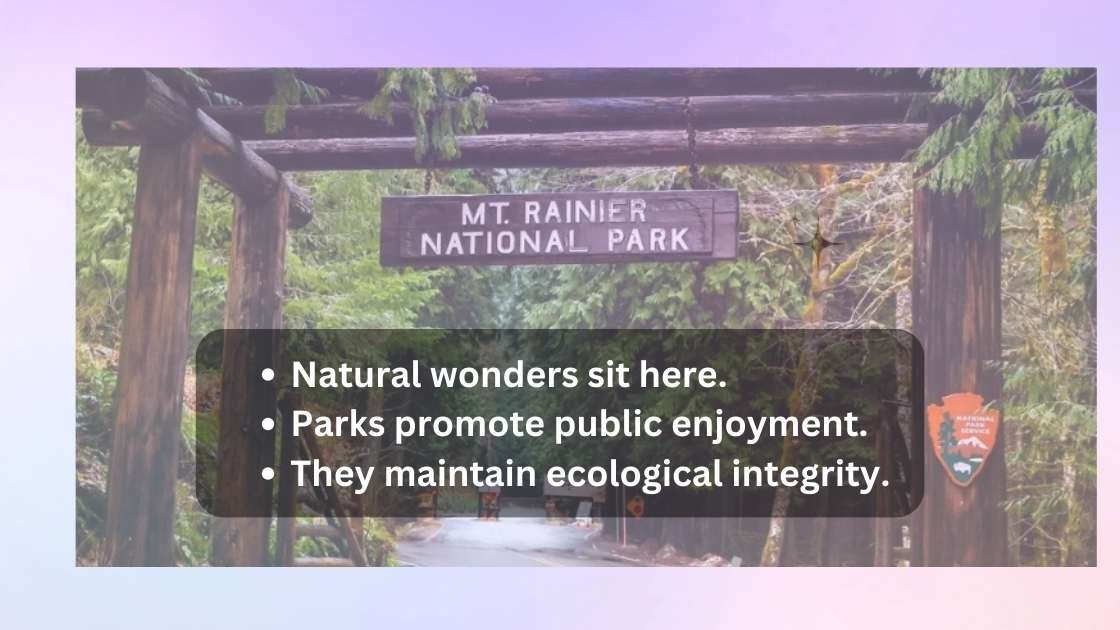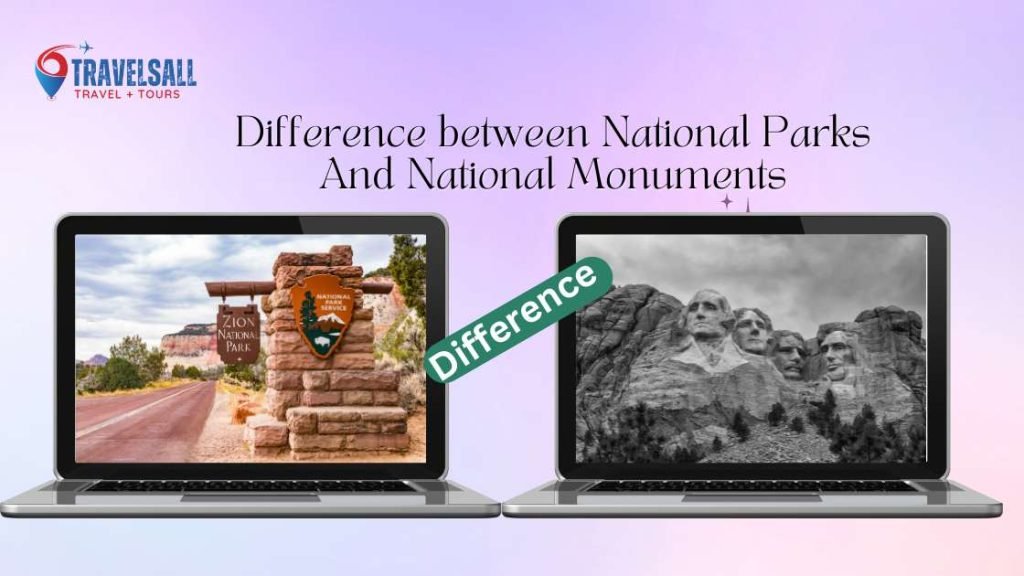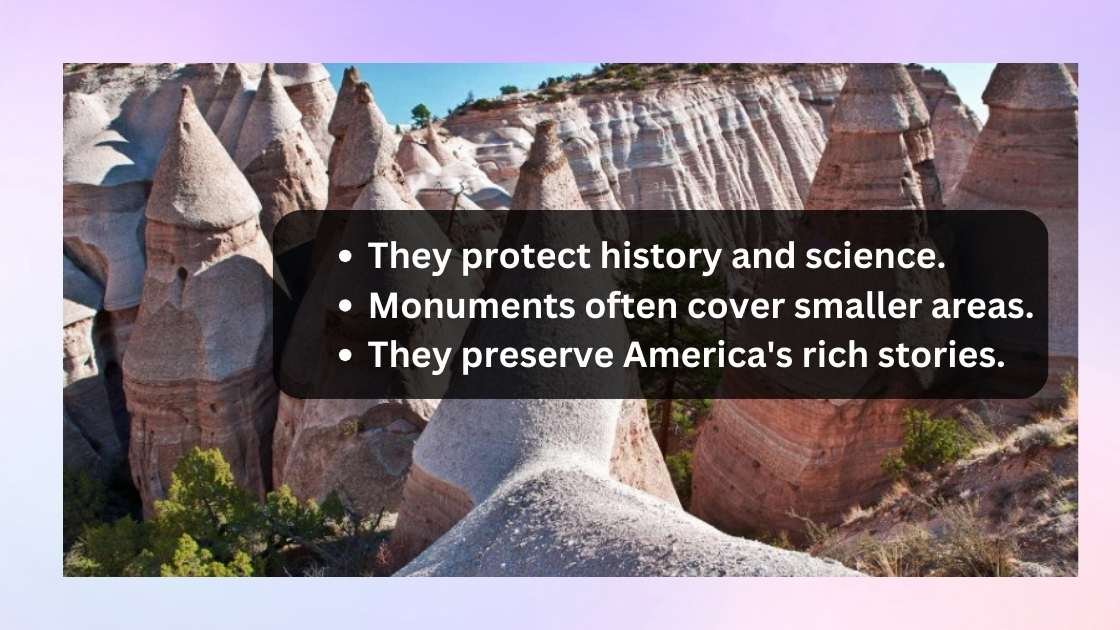National parks are large protected areas preserving natural wonders, whereas national monuments protect a specific historical or cultural feature. National parks often encompass extensive regions with ecosystems to maintain biodiversity, while national monuments safeguard a single, unique landmark or region.
Finding the amazing beauty of special places in America is like finding a bunch of different treasures. There are big wild areas and places with stories from a long time ago.
National parks like Yellowstone or Yosemite are like big safe homes for animals and nature. When you visit, you get to enjoy the wonderful nature around you.
Some special places, like Bears Ears or the Statue of Liberty, are called national monuments. They’re a bit different from national parks.
National parks are big outdoor areas where you can Investigate and enjoy nature. National monuments focus on saving important places with history or cool things to learn about.
Both national parks and monuments help keep our country’s history and beautiful nature safe for everyone, including you, to enjoy and learn from for a long time. Now let’s explain the “Difference between National Parks And National Monuments”
Table of Contents
ToggleNational Parks Vs National Monuments: A Clear Distinction
National Parks and National Monuments serve as guardians of our natural and cultural heritage.
While both protect precious landscapes, they have different goals and rules.
This post Investigates these differences clearly and simply.
The Core Purpose Of Each

National Parks focus on preserving natural beauty, wildlife, and recreation areas for public enjoyment.
- Natural wonders sit here.
- Parks promote public enjoyment.
- They maintain ecological integrity.
National Monuments, on the other hand, protect specific historical, cultural, or scientific interests.
- They protect history and science.
- Monuments often cover smaller areas.
- They preserve America’s rich stories.
Legal Framework Governing The Two
A different set of laws governs each type of site.
National Parks are established by Congress and require an act of legislation.
National Monuments are typically created by presidential proclamation under the Antiquities Act.
| Aspect | National Parks | National Monuments |
|---|---|---|
| Established By | Congress | President |
| Size | Usually larger | Often smaller |
| Focus | Natural beauty and recreation | Historical, cultural significance |
The Birth Of Conservation: Historical Context
The birth of conservation in the United States marks a pivotal moment in history. This movement was about protecting natural landscapes for future generations.
It acknowledges the unique beauty and value of our country’s lands. It sparked the creation of National Parks and National Monuments.
Early Movements And Legislation
Conservation efforts began with the recognition of America’s natural wonders. People saw a need to preserve these spaces. Laws and policies were put in place to protect them. Here are the key components of this early phase:
- Yosemite Grant Act: Signed in 1864, it was the first U.S. law to protect wild land.
- National Park Service Organic Act: In 1916, this act created the National Park Service. Its goal was to conserve and manage parks.
Key Figures In American Conservation History
Several notable individuals championed the conservation cause. They fought hard to secure protection for natural areas. Below are the towering figures of early conservation:
| Name | Contribution |
|---|---|
| John Muir | Known as the ‘Father of National Parks,’ Muir founded the Sierra Club. |
| Theodore Roosevelt | As President, Roosevelt signed into creation of five National Parks and 18 National Monuments. |
| Gifford Pinchot | He was the first Chief of the U.S. Forest Service, promoting sustainable management of forests. |
National Parks: America’s Natural Treasures

United States National Parks protect some of the most incredible landscapes in the country. They draw millions of visitors each year. People come to see stunning sights and rare wildlife.
Parks like Yellowstone and Yosemite have become famous worldwide. They show the beauty of America’s great outdoors.
Criteria For National Park Designation
To become a national park, a place must have unique natural features. These features are unlike any other in the country. The land must be pristine.
It should have historic or scenic value. Congress makes the final decision to create a new park. They pass a special law for it.
- Scenic Beauty: Breathtaking landscapes are a must.
- Recreation: The area should offer chances for fun outdoors.
- Natural or Historic Interest: Unique historical or natural wonders.
Ecosystems And Biodiversity Protection
National parks protect habitats for countless species. These places are home to plants and animals that may be rare or endangered.
The parks provide safe spaces for them to live and grow. They help keep ecosystems healthy. This is vital for the environment.
| Ecosystem Services | Examples From National Parks |
|---|---|
| Water Purification | Rivers in national parks give clean water. |
| Air Quality | Park forests help make the air fresh. |
| Climate Regulation | Trees store carbon, slowing climate change. |
Exploring National Monuments: Landmarks Of Significance
Many of us have heard about national parks and national monuments, but what makes them different?
National monuments hold secrets of the past and present for everyone to find. Let’s dive into the wonders of these landmarks of significance.
Designation Of National Monuments
National monuments get their status from Presidents. They use the Antiquities Act. This act gives them power to protect special land. A president sees important features in these places. Then they become national monuments.
- Unique natural features can make a place a monument.
- History can play a part too.
- Sometimes, these places have special plants or animals.
Cultural And Historic Emphasis
National monuments often tell stories. They share human history or cultural tales. Some have ancient ruins. Others might have battlegrounds from long ago.
| Emphasis | Examples |
|---|---|
| Cultural | Native American sacred sites |
| Historic | Civil War battlefields |
| Natural | Volcanic landscapes |
National monuments protect these stories. They keep them safe for all to learn and enjoy.
Management And Operations: Who Runs The Show?
National Parks and National Monuments are like special places in the United States that are important. People go there to see cool nature and old things that teach us about history.
But, some special people take care of these places to make sure they stay beautiful and everyone can visit them. Let’s learn about how these places are managed and who helps to keep them nice for everyone.
Differences In Managing Agencies
National Parks and National Monuments fall under the care of different federal agencies based on their designated purpose and land use priorities. Let’s investigate who is at the helm for each:
- National Parks are primarily managed by the National Park Service (NPS), an agency focused on preserving natural and cultural resources.
- National Monuments can be overseen by various agencies including the NPS, Bureau of Land Management (BLM), or even the Forest Service, each bringing their unique conservation expertise to the table.
Variations In Funding And Resources
The financial support and resources allocated to these spectacular areas differ significantly. A closer look reveals how it influences their operations:
| Protected Area | Source of Funding | Impact on Operations |
|---|---|---|
| National Parks | Federal budget, entry fees, donations | Funds geared towards extensive visitor facilities and educational services. |
| National Monuments | Varies by managing agency | May focus more on preservation with limited visitor services, depending on the site. |
In summary, funding influences how each site operates. National Parks often have robust budgets for visitor services. National Monuments‘ budgets may concentrate on protecting key features unique to their designation.
Visitation Rights And Public Access

Exploring the great outdoors is thrilling, and knowing the difference between National Parks and National Monuments improves that experience.
Visitation Rights and Public Access determine how we can enjoy these spaces. Each has unique rules and offerings for recreation and education.
Accessibility For Recreation And Education
National Parks and National Monuments both offer incredible opportunities for recreation and learning. National Parks tend to be more accessible, with extensive facilities like visitor centers, guided tours, and marked trails. These parks welcome a wide range of activities, from camping to wildlife viewing.
- Visitor centers with educational exhibits
- Guided tours and ranger programs
- Designed trails for hiking, biking, and more
In contrast, National Monuments might be less developed but are treasure troves for historical and scientific interest. Accessibility varies, with some offering similar amenities to National Parks while others preserve a more undisturbed environment.
- Specific sites for scientific research
- Some monuments have limited visitor facilities
- Focused on the preservation of historical assets
Regulations On Visitor Activities
While visitor access is a priority, regulations ensure the protection of these important areas. National Parks generally have stricter rules to minimize impact on the environment.
Specific areas may be off-limits to protect wildlife habitats or sensitive ecological zones. Visitor activities are closely monitored.
| National Park Regulations | National Monument Regulations |
|---|---|
| Camping in designated areas | Research with permit |
| Wildlife should not be disturbed | Artifact collection prohibited |
| Leave no trace principles | Areas may be restricted for preservation |
National Monuments may offer more flexible access but always within the scope of safeguarding the site’s integrity. Activities like climbing or off-roading might be allowed in some monuments, provided they don’t harm the monument’s resources.
The Politics Of Land: Controversies And Debates
Managing America’s vast landscapes often ignites fiery debates. National Parks and Monuments are at the heart of these political standoffs.
Different administrations have clashing views on land use and conservation strategies. This fuels controversies over land designations and their modifications or reversals.
Political Clashes Over Land Designations
The line between National Parks and Monuments can be contentious. National Parks require an act of Congress to establish. Presidents may declare National Monuments by executive orders under the Antiquities Act. This flexibility often leads to political disputes. Here are key areas of contention:
- Conservation vs Development: Balancing environmental protection with economic growth sparks conflicts.
- States vs Federal: Who should control these lands? States seek more influence, challenging federal authority.
- Recreation vs Preservation: Finding harmony between human enjoyment and preserving natural resources is a delicate task.
Controversial Modifications And Reversals
Changing a National Monument’s status can be polarizing. Presidents may reduce or expand Monuments, leading to public outcry or support. These actions raise legal and ethical questions. Consider these examples where modifications caused an uproar:
| Monument | Action | Administration | Year |
|---|---|---|---|
| Bears Ears National Monument | Reduction in size | Prior Administration | 2017 |
| Grand Staircase-Escalante National Monument | Size decreased | Prior Administration | 2017 |
These changes led to lawsuits and discussions on the proper use of executive powers. National Monuments face uncertain futures with shifting political tides.
Conservation Success Stories
Across the United States, National Parks and National Monuments stand as testaments to both natural beauty and historic significance.
These special places have amazing views and important nature. They’re not just for fun, but also to keep safe and help rare animals and homes for them. Hearing about how people take care of these places makes us happy and excited, showing that we can protect our Earth’s special things.
Ecosystem Revitalization
Through targeted initiatives, national conservation areas have seen remarkable rebounds in ecosystem health. Action plans focus on restoring natural processes and removing invasive species. Success is evident in the flourishing flora and fauna within these protected realms.
- Fire management: Controlled burns stimulate new growth.
- Water conservation: Replenishing wetlands encourages biodiversity.
- Habitat construction: Fake bird homes help more birds have babies.
In places like Yellowstone National Park, efforts to control wildfires have prevented damage to essential habitats. Strict anti-poaching laws have further supported ecosystem recovery, ensuring predators and prey thrive in balance.
Species Recovery
The return of once-endangered species marks a significant milestone for these sanctuaries. Intense conservation programs, breeding, and reintroduction of species have borne fruit in multiple locations.
- Bald Eagles: From the brink of extinction to stable numbers.
- Gray Wolves: Revived in Yellowstone, they now reign freely.
- California Condors: Monumental efforts have revived populations.
Efforts in Channel Islands National Park have successfully repopulated the Island Fox, transforming it from critically endangered to a shining example of recovery.
Cultural Preservation Achievements
National Monuments are like giant nature and history museums. They save cool things in nature and important stories from the past. Places like Bear Ears have memories from a long time ago that help us know about old societies.
Valuable things are watched over, and we learn about them in school programs to pass the stories to kids in the future.
- Archaeological sites: Guarded against looting, they continue to educate.
- Historic structures: Restored to demonstrate architectural evolution.
- Indigenous traditions: Preserved through collaborative management.
Concerning ancestral lands, monuments like the Grand Canyon-Parashant National Monument remain sanctuaries for ancient dwellings and petroglyphs, guarded for posterity.
The Future Of Protected Lands In America

America’s treasured landscapes face a dynamic future. National parks and monuments, our nation’s crown jewels, anticipate fresh conservation challenges. These sanctuaries require innovative strategies to ensure their preservation for generations to come.
Emerging Challenges In Conservation
Climate change looms as a formidable foe, altering ecosystems and wildlife patterns. Our beloved parks and monuments grapple with the effects of a warming planet. Invasive species pose another threat, disrupting native flora and fauna. Tourist footfall, while vital for support, weighs heavily on delicate habitats. These issues demand urgent action to protect these sacred spaces.
- Changing climate patterns affecting native species
- Invasive species threatening biodiversity
- Increased visitation pressure on natural resources
Innovations And Policies Shaping Tomorrow
Hope kindles with the advent of cutting-edge conservation technology. Bioinformatics plays a crucial role, in offering data for better wildlife management. Next, we see eco-friendly infrastructure, minimizing human impact. Policies evolve, too, pushing for sustainable tourism and local community support. These advances spearhead the way to smarter park stewardship.
| Conservation Tool | Impact |
|---|---|
| Bioinformatics | Improved species monitoring |
| Eco-Infrastructure | Reduced habitat disruption |
| Policy Reform | Sustainable tourism growth |
Frequently Asked Questions On Difference Between National Parks And National Monuments
What Is The Difference Between National Parks And Monuments?
National parks protect natural landscapes and ecosystems, offering recreation and conservation. Monuments preserve specific historical, cultural, or scientific interests, often designated for unique landmarks or objects. Both are federally managed but often differ in size and purpose.
Are National Monuments Part Of The National Park System?
National monuments are not inherently part of the National Park System but some are managed by the National Park Service.
What Is The Main Difference Between A National Park And A National Preserve?
A national park prioritizes conservation, often limiting activities like hunting, while a national preserve allows for more recreational practices, including hunting and fishing, under regulated conditions.
Who Decides What Is A National Park Or A National Monument?
The U. S. Congress establishes national parks, while the President designates national monuments under the Antiquities Act.
Conclusion
Exploring our nation’s natural and historical treasures can be a profound experience. National parks and national monuments differ in reasons for preservation and management. Yet, both offer unparalleled insights into our collective heritage and natural beauty. Remember these distinctions when planning your next adventure to ensure a deeper appreciation for these iconic American landscapes.




